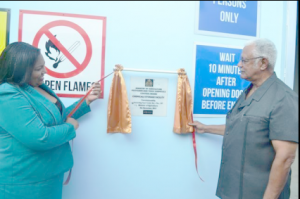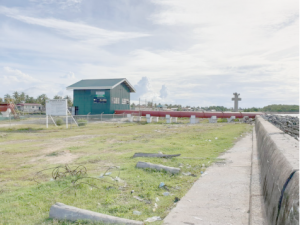THE proverbial “backbone” of Guyana’s economy has been its bountiful agriculture sector, a sector which has made major strides over the past five years under the A Partnership for National Unity and Alliance For Change (APNU+AFC) administration.
The Ministry of Agriculture, in its report on the performance of the sector over the past five years, said agriculture is a mainstay in Guyana’s development. Guyana’s history has been one where agriculture has been the backbone of the economy and, the sector has been a catalyst and a pillar in our development trajectory.

Agriculture contributes almost 16 per cent of the Gross Domestic Product (GDP) and accounts for more than 17.8 per cent of employment. Additionally, almost 26 per cent of Guyana’s export earnings come from agriculture. And, an average of about five per cent of the national budget is allocated to agriculture.
Sustaining and improving the output and productivity of the sector has not been an easy task, but over the period, 2015-2020, the Ministry of Agriculture has worked to reduce disaster risk, increase productivity, and increasing exports.
According to the ministry, reducing disaster risk has been addressed by programmes focused on drainage and irrigation and hinterland development, while programmes to increase productivity and exports focused on technology and extension support, and market-led production via export promotion and import substitution.
These interventions targeted the subsidiaries of the sector, which include livestock, fisheries, crop, irrigation and drainage, pesticide management and control and, the marketing of agriculture produce.

In a sectoral breakdown, the ministry said the National Drainage and Irrigation Authority (NDIA) has been building its capacity, by acquiring a significant number of equipment, inclusive of mobile and fixed pumps, long reach excavators, bulldozers and other machinery.
The NDIA has adopted a policy of constructing and rehabilitating sluices that are found to be functional through suitable foreshore conditions along the coast and riverine areas, aimed at upgrading and expanding the drainage system. These works allow for expanded acreage of agricultural activities and to better cope with extreme rainfall events associated with climate change.
As part of improving drainage and irrigation across the country, the NDIA has installed pump stations across regions Two, Three, Four, Five and Six. A number of pump stations have been built and rehabilitated across the coastland at a cost of $2,921,000,000.
The areas benefitting from this investment include Lusignan, BV/Triumph, Good Hope and its environs, Friendship, Vigilance, Buxton, Herstelling/Mocha/Providence, Hope and Enmore in Region Four; Three Friends, Columbia, Aberdeen, Land of Plenty, Mainstay, Lima and Reliance in Region Two; Trafalgar in Region Five; Windsor Forest in Region Three; Bengal, Gangaram, Eversham and Joppa in Region Six.
In addition to improving drainage, NDIA has assisted 100 hinterland farmers to improve the agricultural activities and productivity of 120 acres at a value of $20M.
“NDIA intends to obtain the requisite agricultural equipment and associated implements to assist farmers in the preparation of their fields. These services will also be available to ensure efficient harvesting and transport of crops,” said the agriculture ministry.
This project will also ensure that farmers can access the readily available market of the school feeding programme in the region as well as to develop intercommunity agricultural trade, since the majority of food items have to be sourced from outside the hinterland communities and transported at high cost.
Production and productivity are important, but the quality of the produce is also very important. And, it is to this end that another subsidiary of the Ministry of Agriculture, the Pesticides and Toxic Chemicals Control Board (PTCCB), has sought to manage the use of pesticides and eradicate the use of illegal and unregulated substances.
Pesticides have been linked to a wide range of human health illnesses, ranging from short-term impacts such as headaches and nausea, to chronic impacts like cancer, cognitive disorders, reproductive harm, and endocrine disruption. It is important to note that these health impacts are inherently linked to poor pesticide use and practices.

In consideration of those effects, the PTCCB had commissioned a state-of-the-art Chemical Storage Facility for Guyana during 2015. The facility is housed in the compound of the National Agricultural Research and Extension Institute (NAREI). The PTCCB continues to emphasise the need for proper storage facility to house seized illegal and unregistered pesticides found in Guyana. The facility was completed in 2015 at a cost of $46M.
Education and training is, however, important to ensure that stakeholders understand the adversities related to the use of those chemicals and even learn the best practices in the agriculture sector.
The Guyana School of Agriculture has been doing its part to ensure that stakeholders are educated and trained. And, to improve its capacity, the school embarked on a process to reform its curriculum in November 2016 to make it more responsive to the needs of stakeholders. This process, which was spearheaded by a Curriculum Review Committee (CRC), a broad based committee comprising representation from the major stakeholders within the Sector, was completed in December 2019.
New programme structures were developed and the courses within each programme were comprehensively reviewed, with each conforming to a specific template consisting of 18 descriptors. The new outlines resulting from this process are in full use.
These courses will allow budding professionals in the sector to inherit not only what exists, but also the advanced and innovative initiatives undertaken by the National
Agricultural Research and Extension Institute (NAREI).
Over the last five years, NAREI has placed emphasis on crop diversification, something which enabled the Ministry of Agriculture to record a 29.5 per cent increase in production of non-traditional crops in the first half of 2019.
In 2014, production stood at 436,878 MT compared with 709,496 MT for 2018. NAREI’s diversification thrust has seen expansion in acreages for ginger, pepper, turmeric, black pepper, carrots, new varieties of sweet potatoes and onions encouraging more farmers to return to the land.
During 2015 to 2019, the average annual exports of non-traditional commodities stood at approximately 10,000 metric tonnes with a value of approximately GYD$3 billion per year, with coconut, pumpkin, watermelon, eddo, pineapples, mango among the top exports
The significant contributions of agriculture as a major component of the local economy is likely to persist, even though the country envisages accelerated growth because of the oil and gas sector.



.jpg)








